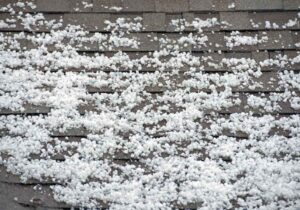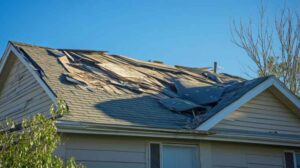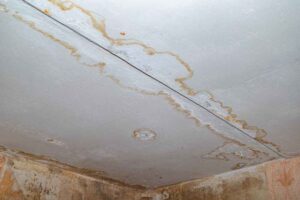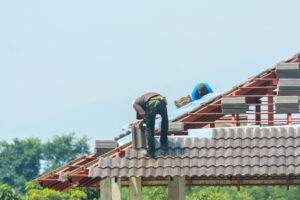Imagine this: you’re lounging on your couch during a quiet evening when you hear it — drip. Another drip. You look up, and there’s a faint stain blooming on the ceiling. Yep. Your roof is leaking — but only in one spot.
What gives?
Whether it’s a mysterious ceiling stain or water dripping from the roof outside, a one-spot leak may seem like no big deal. But it’s often the red flag for something more serious — hidden damage that could compromise your roof’s integrity.
In this guide, we’ll break down:
- Why your roof may be leaking in just one spot
- Common causes and hidden culprits
- What to do ASAP (hint: don’t grab the duct tape)
- How to fix it right the first time
- Tips to prevent repeat leaks
Let’s get your roof back to doing what it does best — keeping the weather out and your peace of mind in.
Why Is My Roof Leaking Water in Just One Spot?
A roof leak that’s isolated to one location can be deceiving. It might look like a minor nuisance, but leaks don’t always follow a straight path — water travels.
Common Causes of a Localized Roof Leak:
- Cracked flashing – That thin metal around chimneys, vents, and valleys can corrode or shift over time.
- Compromised roof underlayment – A weak layer beneath shingles can allow water to seep through.
- Vent boot failure – Those rubber seals around plumbing vents can dry out and crack.
- Ice dams – In colder climates, these can trap melting snow under your shingles.
- Gutter backups – Water overflows and sneaks under the edge of your roof.
Internal vs. External Signs:
- Inside: Water stains, peeling paint, mildew smells, sagging drywall
- Outside: Buckled flashing, loose seals around penetrations, missing granules near leak origin
Pro Tip: A “one spot” leak is often just the visible part. The actual water entry point could be several feet away.
Internal Link Opportunity: For a full breakdown of common roof issues, check out [Most Common Roof Repairs].
Water Dripping From Roof Outside? Do This First
When you spot water dripping from your roof’s edge — even when it’s not raining — it can indicate a bigger issue like trapped moisture or clogged drainage.
Immediate Steps to Take:
- Turn off electricity if the leak is near light fixtures.
- Contain the leak with buckets or towels to minimize damage.
- Document the damage (photos/videos) for potential insurance claims.
- Don’t climb the roof — especially when it’s wet or stormy.
Quick DIY Checks You Can Do Safely:
- Inspect the attic for wet insulation or water trails.
- Look for signs of condensation, especially around vents.
- Use binoculars to scan for lifted shingles or cracked flashing.
Roof Leaking But Shingles Look Good? Here’s What’s Really Going On
This one throws a lot of homeowners off. You head outside, inspect the roof, and everything looks intact. So why the leak?
Here’s What Could Be Hiding Beneath the Surface:
- Flashing failure beneath shingles — especially at valleys and around chimneys.
- Improperly sealed roof penetrations — like skylights, vents, or solar panel mounts.
- Ventilation issues — cause moisture buildup inside the attic that drips down.
- Nail pops — fasteners backing out over time create entry points.
Reminder: Water doesn’t always enter at the leak point. It can travel along rafters or beams and show up far from the source.
Internal Link Opportunity: Learn more about misleading damage signs in [Wind Damage Roof Shingles].
Diagnosing a Roof Leak Like a Pro
Fixing a leak without knowing its exact source is like playing whack-a-mole with your wallet. Here’s how the pros get it right:
Tools Roofers Use:
- Moisture meters – detect damp spots even behind insulation.
- Infrared cameras – show cold/wet areas invisible to the eye.
- Controlled hose tests – isolate the source by mimicking rainfall.
When to DIY vs. Hire Help:
Scenario | DIY-Friendly? |
Replacing vent boot | Maybe, if you’re handy and it’s dry |
Flashing leak around chimney |
|
Replacing shingles | Only if minor and you’re comfortable on a roof |
Leak recurring in the same spot | Definitely call a roofer |
How to Fix a Leak in One Spot on Your Roof
So you’ve found the leak (or at least narrowed it down). Here’s what your options look like:
Short-Term Fixes:
- Roofing tape or flashing sealant to patch small cracks
- Tarping the roof securely until a contractor can assess
- Gutter cleaning if overflow was the cause
Long-Term Repairs:
- Replace deteriorated flashing or underlayment
- Reseal or replace vent boots and pipe collars
- Patch or replace shingles in the affected area
Pro Tip: Even if it’s “just one spot,” improper repairs can void your roof warranty or insurance coverage. Always use certified materials and methods.
Internal Link Opportunity: Learn how to file a claim for storm-related roof leaks at [Roof Damage Insurance Claim Process].
How to Prevent Future One-Spot Leaks
The best leak is the one that never happens. Here’s how to protect your roof moving forward.
Maintenance Checklist:
- Inspect flashing and vent boots every 6 months
- Clean gutters and downspouts seasonally
- Check attic for moisture/mold signs quarterly
- Seal around chimneys and skylights annually
Upgrade Weak Spots:
- Use high-performance flashing (e.g., metal not rubber)
- Add ice/water shield underlayment in snowy regions
- Improve attic ventilation to reduce condensation
FAQs About Roof Leaking in One Spot
Can a roof leak in one spot but still be structurally sound?
Yes — but it’s still a sign of vulnerability. Ignoring it could lead to mold, wood rot, or insulation damage.
How do I find the exact source of a leak?
Follow water stains in the attic, or use a moisture meter. Still unsure? A roofing contractor will pinpoint it using thermal imaging or controlled testing.
Should I replace the whole roof over one leak?
Not usually. If your roof is under 15 years old and the damage is localized, targeted repair is often enough — unless there’s a systemic issue like poor installation.
How much does it cost to fix a one-spot leak?
On average, expect to pay between $150–$600 for minor repairs, or more if structural components (like decking) are affected.
Final Thoughts: Don’t Ignore That One Drip
A roof leak in one spot may seem small, but it’s often the tip of a very soggy iceberg. Whether it’s a slipped flashing, a hidden puncture, or blocked gutters wreaking havoc, ignoring the signs can lead to far bigger (and costlier) problems.
Here’s your next step:
Get it inspected now — before minor becomes massive. Protect your home, preserve your investment, and sleep easy knowing the only thing dripping is your fresh-brewed coffee.
Book a professional roof inspection today. Don’t wait until it’s raining in your living room.

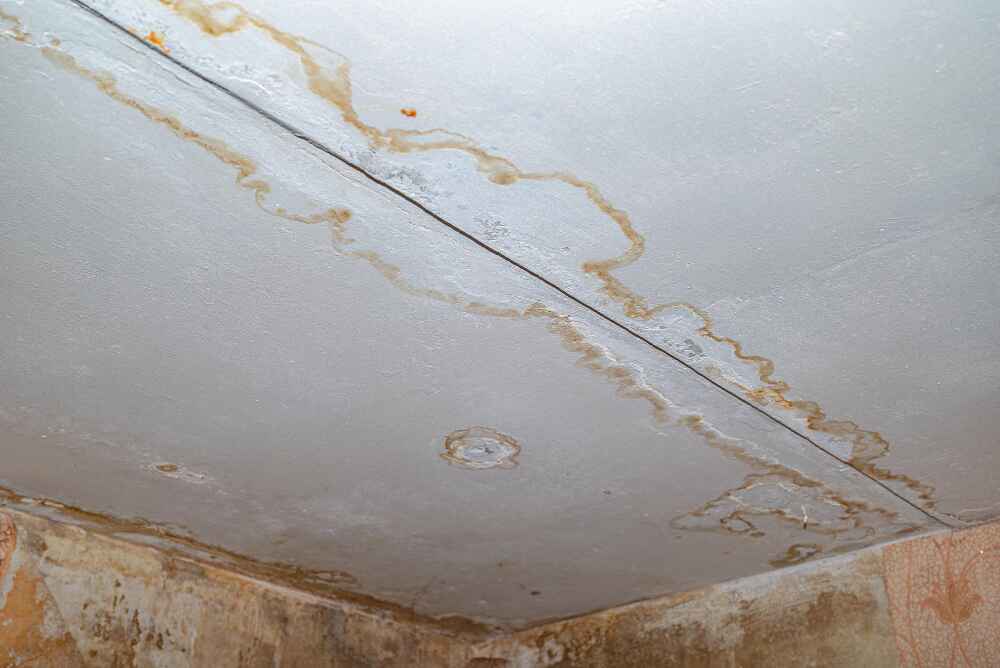
 Call a pro — risk of structural damage
Call a pro — risk of structural damage